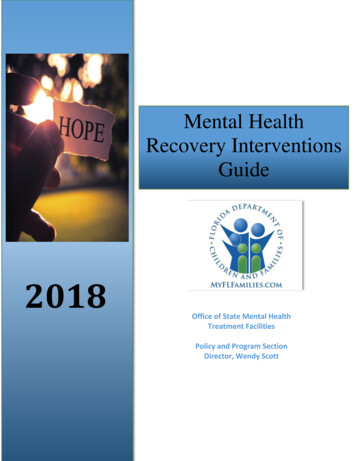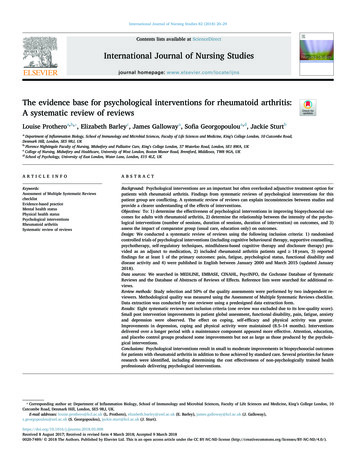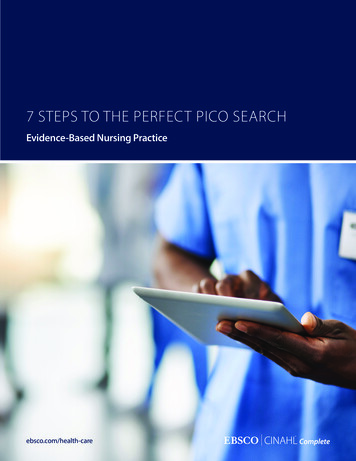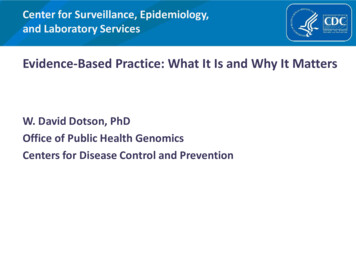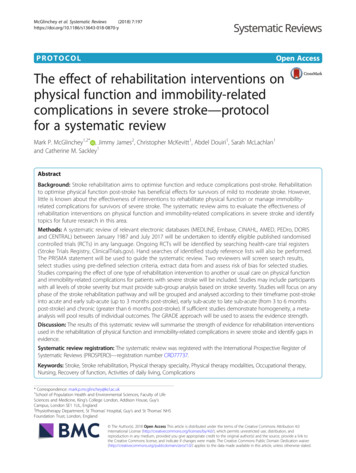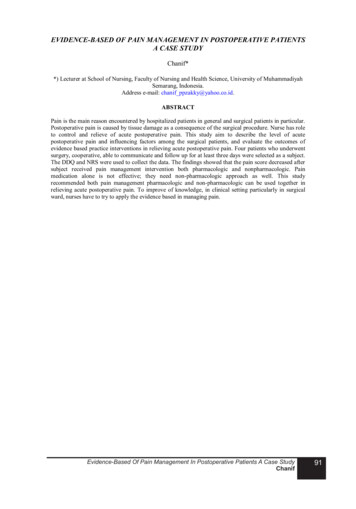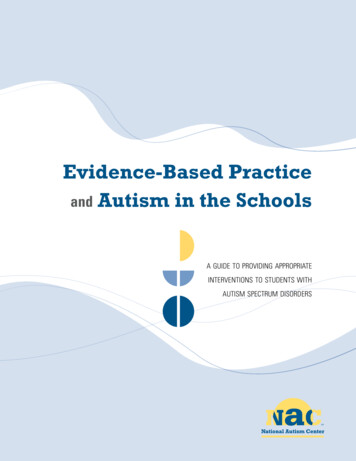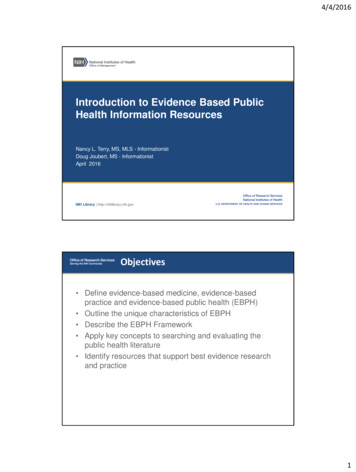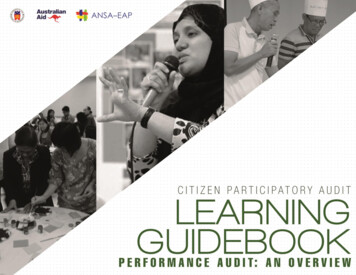
Transcription
CMS Webinar: Evidence-basedInterventions to Reduce AvoidableHospitalizations of Nursing HomeResidentsParticipants:Evan Shulman, CMS MMCOLewis Lipsitz, MD, ModeratorJoseph Ouslander, MDAlice Bonner, RN, PhDJoseph Hanlon, PharmDMary Jane Koren, MD
Initiative to Reduce Avoidable HospitalizationsAmong Nursing Facility Residents More information, including the full funding opportunityannouncement can be found athttp://innovation.cms.gov/initiatives/rahnfr/ CMS will not be discussing or answering questions regarding thetechnical requirements of the Initiative (e.g., eligibility, how to apply,etc.). Questions of this nature may be submitted toNFInitiative2012@cms.hhs.gov. The views expressed in this presentation are the views of eachspeaker and do not necessarily reflect the views or policies of theCenters for Medicare & Medicaid Services. The material providedis intended for educational use and the information contained withinhas no bearing on participation in any CMS program.
Overview of Promising Interventions Care Protocols and Staff Training (Ouslander)– INTERACT II reduced hospital admissions by 17% (Ouslander,2011). Professional Staff Models – MD/NP Collaboration (Bonner)– Evercare reduced hospital admissions by 47% and emergencydepartment use by 49% (Kane, et. al, 2004).– Nursing facility-employed staff provider model in NY reducedMedicare costs by 16.3% (Moore & Martelle, 1996). Medication/Pharmacy Interventions (Hanlon) Organizational Changes – Advancing Excellence in LTCCollaborative (http://www.nhqualitycampaign.org) (Koren) Other ancillary strategies: Staff & caregiver education, Telemedicalsupport, EMR and alerts, Advanced Care Planning ALL OF THE ABOVE.
References Berkowitz, R. E., Jones, R. N., Rieder, R., Bryan, M., Schreiber, R.,Verney, S. and Paasche-Orlow, M. K. (2011), Improving DispositionOutcomes for Patients in a Geriatric Skilled Nursing Facility. Journalof the American Geriatrics Society, 59: 1130–1136. Crotty M, Rowett D, Spurling L, Giles LC, Phillips PA. (2004). Doesthe addition of a pharmacist transition coordinator improve evidencebased medication management and health outcomes in older adultsmoving from the hospital to a long-term care facility? Results of arandomized, controlled trial. Am J Geriatr Pharmacother, 2:257-64. Foy White-Chu E., Graves W., Godfrey S., Bonner A., Sloane P.D.(2009). Beyond the Medical Model: The Culture Change Revolutionin Long Term Care. Journal of the American Medical DirectorsAssociation,10(3), B6. Gozalo, P.L. & Miller, S.C. (2007). Hospice Enrollment andEvaluation of Its Causal Effect on Hospitalization of Dying NursingHome Patients. Health Services Research, 42(2): 587–610.
References Continued Katz P.R., Karuza J., Intrator O., Zinn J., Mor V., Caprio T., CaprioA., Dauenhauer J., Lima J. (2009) Medical staff organization innursing homes: scale development and validation. Journal of theAmerican Medical Directors Association, 10(7), 498-504. Kane, R. L., Flood, S., Bershadsky, B., & Keckhafer, G. (2004).Effect of an Innovative Medicare Managed Care Program on theQuality of Care for Nursing Home Residents. The Gerontologist, 44(1), 95-103. Loeb M., Brazil K., Lohfeld L., McGeer A., Simor A., Stevenson K.,Zoutman D., Smith S., Liu X., Walter S.D. (2005). Effect of amultifaceted intervention on number of antimicrobial prescriptions forsuspected urinary tract infections in residents of nursing homes:cluster randomised controlled trial. BMJ, 24;331(7518), 669 Marcum Z.A., Handler S.M., Wright R., Hanlon J.T. (2010).Interventions to improve suboptimal prescribing in nursing homes: Anarrative review. Am J Geriatr Pharmacother, 8(3)183-200.
References Continued Miller, S.C., Gozalo, P., & Mor, V. (2001). Hospice enrollment andhospitalization of dying nursing home patients. Am J Med, 111, 3844. Moore, S., & Martelle, M. (1996). Alternative Models of EnsuringAccess to Primary Medical Care in Nursing Facilities DemonstrationProject: Final Report. New York: Bureau of Health Economics, NYSDepartment of Health. Ouslander J. G., Lamb G., Tappen R., Herndon L., Diaz S., Roos B.A., et al. (2011). Interventions to Reduce Hospitalizations fromNursing Homes: Evaluation of the INTERACT II CollaborativeQuality Improvement Project. Journal of the American GeriatricsSociety, 59 (4), 745-753. Zermansky A., Alldred D., Petty D., Raynor D., Freemantle N.,Eastugh J., et al. (2006) Clinical medication review by a pharmacistof elderly people living in care homes – randomised controlled trial.Age Ageing 35: 586–591.
The INTERACT Program:What is It and Why Does It Matter?(“Interventions to Reduce Acute Care Transfers”)Is a quality improvement program designedto improve the care of nursing home residentswith acute changes in condition Florida Atlantic University 2011
The INTERACT Program:What is It and Why Does It Matter? Includes evidence and expert-recommendedclinical practice tools, strategies to implementthem, and related educational resources The basic program is located on the internet:http://interact2.net Florida Atlantic University 2011
The INTERACT Program:What is It and Why Does It Matter?The INTERACT Interdisciplinary TeamJoseph G. Ouslander, MDLaurie Herndon, GNPGerri Lamb, PhD, RN, FAANRuth Tappen, EdD, RN, FAANSanya Diaz, MDJohn Schnelle, PhDSandra Simmons, PhDAnnie Rahman, MSWJo Taylor, RN, MPHMary Perloe, GNPDan Osterweil, MDAlice Bonner, PhD, GNPFlorida Atlantic UniversityMass Senior Care FoundationArizona State UniversityFlorida Atlantic UniversityFlorida Atlantic UniversityVanderbilt UniversityVanderbilt UniversityCalifornia Association of LTC MedicineThe Carolinas Center for Medical ExcellenceThe Georgia Medical Care FoundationCalifornia Association of LTC MedicineCenter for Medicare and Medicaid ServicesIn collaboration with participating nursing homes Florida Atlantic University 2011
The INTERACT Program:What is It and Why Does It Matter?AcknowledgementThe INTERACT Program and Tools were initially developed by Joseph G. Ouslander, MD and MaryPerloe, MS, GNP at the Georgia Medical Care Foundation with the support of a contract from the Centerfor Medicare and Medicaid Services.The current version of the INTERACT Program, including the INTERACT II Tools, educational materials,and implementation strategies were developed by Drs. Ouslander, Gerri Lamb, Alice Bonner, and RuthTappen, and Ms. Laurie Herndon with input from many direct care providers and national experts in aproject based at Florida Atlantic University supported by The Commonwealth Fund. The CommonwealthFund is a private foundation supporting independent research on health policy reform and a highperformance health system.Some materials herein are Florida Atlantic University 2011. Such materials and the trademarkINTERACTTM may be used with the permission of Florida Atlantic University.Permission can be granted by Dr. Ouslander (jousland@fau.edu) Florida Atlantic University 2011
The INTERACT Program:What is It and Why Does It Matter?CMS Special Study in Georgia – Expert Ratings ofPotentially Avoidable HospitalizationsBased review of 200 hospitalizations from 20 re SHospitalization Rate HomesHospitalization Rate HomesOuslander et al: J Amer Ger Soc 58: 627-635, 2010NO Florida Atlantic University 2011
The INTERACT Program:Background and Why it MattersCMS Study of Dually EligibleMedicare/Medicaid Beneficiaries Florida Atlantic University 2011
The INTERACT Program:What is It and Why Does It Matter? Defining “Preventable”,“Avoidable”, “Unnecessary”hospitalizations is challengingbecause numerous factorsand incentives influence thedecision to hospitalize Risk adjustment is verycomplicatedMaslow, K and , Ouslander, JG: Measurement of Potentially Preventable Hospitalizations.White Paper prepared for the Long Term Quality Alliance, 2012.(Available at: om/images//PreventableHospitalizations 021512 2.pdf Florida Atlantic University 2011
The INTERACT Program:What is It and Why Does It Matter?What Do You and Your Facility Need to TakeAdvantage of These Opportunities? Florida Atlantic University 2011
The INTERACT Program:What is It and Why Does It Matter? Can help your facility safely reduce hospital transfers by:1. Preventing conditions from becoming severe enough torequire hospitalization through early identification and assessmentof changes in resident condition2. Managing some conditions in the NH without transfer whenthis is feasible and safe3. Improving advance care planning and the use of palliativecare plans when appropriate as an alternative to hospitalization forsome residents Florida Atlantic University 2011
The INTERACT Program:What is It and Why Does It Matter? The goal of INTERACT is to improve care,not to prevent all hospital transfers In fact, INTERACT can help with morerapid transfer of residents who needhospital care Florida Atlantic University 2011
The INTERACT Program:What is It and Why Does It Matter? Originally developed in a project supported by theCenter for Medicare and Medicaid Services (CMS) Revised based on input from staff from severalnursing homes and national experts in a projectsupported by The Commonwealth Fund Florida Atlantic University 2011
The INTERACT Program:What is It and Why Does It Matter?Communication ToolsDecision Support ToolsAdvance Care Planning ToolsQuality Improvement Tools Florida Atlantic University 2011
The INTERACT Program:What is It and Why Does It Matter?The INTERACT IItools are meant to beused together inyour daily work inthe nursing homehttp://interact2.net Florida Atlantic University 2011
The INTERACT Program:What is It and Why Does It Matter?Implementation Model in theCommonwealth Fund Grant Collaborative On site training (part of one day) Facility-based champion Collaborative phone calls with up to 10facility champions twice monthly facilitatedby an experienced nurse practitioner Availability for telephone and email consults Completion and faxing of QI Review Tools Florida Atlantic University 2011
The INTERACT Program:What is It and Why Does It Matter?Commonwealth Fund Project ResultsFacilitiesMean Hospitalization Rateper 1000 resident days (SD)Mean Change(SD)95% nAll INTERACT facilities(N 25)3.99 (2.30)3.32 (2.04)- 0.69 (1.47)-0.08 to -1.30Engaged facilities(N 17)4.01 (2.56)3.13 (2.27)- 0.90 (1.28)-0.23 to -1.56Not engaged facilities(N 8)3.96 (1.79)3.71 (1.53)- 0.26 (1.83)-1.79 to 1.27Comparison facilities(N 11)2.69 (2.23)2.61 (1.82)- 0.08 (0.74)- 0.41 to 0.58Ouslander et al, J Am Geriatr Soc 59:745–753, 2011p value0.02RelativeReduction inAll-CauseHospitalizations17%0.0124%0.696%0.723% Florida Atlantic University 2011
The INTERACT Program:What is It and Why Does It Matter?Commonwealth Fund Project Results - Implications1. For a 100-bed NH, a reduction of 0.69 hospitalizations/1000resident days would result in: 25 fewer hospitalizations in a year ( 2 per month) 125,000 in savings to Medicare Part A (using a conservativeDRG payment of 5,000)2. The intervention as implemented in this project cost of 7,700 per facility3. Net savings 117,000 per facility per year Medicare could share these savings to support NHs to furtherimprove careOuslander et al, J Am Geriatr Soc 59:745–753, 2011 Florida Atlantic University 2011
The INTERACT Program:What is It and Why Does It Matter? Questions? Comments? Suggestions?jousland@fau.edu Florida Atlantic University 2011
Potential Roles for Enhanced Care and CoordinationProviders inLong Term CareAlice Bonner, PhD, RNDirector, Division of Nursing HomesOffice of Clinical Standards and QualityCenters for Medicare & Medicaid ServicesApril 17th, 2012
Why consider enhanced APN/MD roles in yourfacility? Growing body of evidence that LTC residentsbenefit from APN or team care, specificallyimproved clinical outcomes, loweredhospitalization rates and decreased costs What do models of care look like? What are theways that APNs and physicians can collaborateand what are the challenges to implementation?
Evercare Studies Incidence of hospitalizations was twice as high incontrol versus Evercare residents (p .001) Same pattern for preventable hospitalizations (p .001) Savings of 103,000 per year in hospital costs (in 2003dollars) More efficient care, comparable qualityKane, RL et al, 2003. The Effect of Evercare on Hospital Use. JAGS. 51:14271434.Kane, RL et al, 2004. Effect of an Innovative Medicare Managed careprogram on the quality of care for nursing home residents. Gerontologist.44(1): 95-103.
CMS Special Study on PotentiallyAvoidable TransfersExpert Panel Review of Potentially Avoidable TransfersContributing FactorsBetter quality of care would have preventedor decreased severity of acute changeOne physician visit could have avoided thetransferBetter advance care planning would haveprevented the transferThe same benefits could have been achievedat a lower level of careThe resident’s overall condition limited hisability to benefit from the transferResources Needed to Manage in the NHPhysician or physician extender presentin nursing home at least 3 days per weekExam by physician or physician extenderwithin 24 hoursNurse practitioner involvementRegistered nurse (as opposed to LPN orCNA) providing careAvailability of lab tests within 3 hoursCapability for intravenous fluid therapyOuslander et al: J Amer Ger Soc 58: 627-635, 2010
Definition of Collaboration Collaboration is a joint and cooperativeenterprise that integrates the individualperspectives and expertise of variousteam members Themes of collaborative relationshipsinclude collegial relationships, teamwork,open communication, recognition of oneanothers’ expertise; respect, and trust
Advantages to Collaborative Practice Models NP may take calls from facilities orpractices and contact physicians asnecessary Provides detailed assessment of thepatient for physician review Maintains ongoing and current residentinformation, permitting the NP to provideupdates on residents’ general health status
Advantages to Collaborative Practice Models Coordinates and facilitates specialtyreferrals and communication betweenspecialists and primary care providers Can provide alternate regulatory visits inlong term care settings as appropriate,freeing up physician time for more acuteproblems Facilitates care coordination amongfamily, staff and medical providers
Advantages to Collaborative Practice: clinicalquality In SNF/NF, advanced practitioner onsite more often;provides timely, detailed assessment of acutely illresidentsOnsite evaluation of ill residents may enable higher levelof care to be delivered in the nursing facility, avoidingunnecessary hospital transferMore detailed, onsite evaluation of fever may reduceinjudicious antibiotic use and may reduce antimicrobialresistance in LTC over timeMore advanced, onsite evaluation of skin problems mayprevent pressure ulcer developmentMore advanced assessment of behavioral issues indementia may prevent unnecessary psychiatrichospitalization
Advantages to Collaborative Practice: clinicalquality In LTC, expanded provider role mayinclude nursing staff education,mentoring; encouraging professionaldevelopment Presence of an enhanced team mayreduce nursing staff turnover Team may assist with data tracking andmanagement, systems improvements(Quality Assurance PerformanceImprovement or QAPI)
Advantages to Collaborative Practice: physiciansatisfaction Based on a survey of nearly 700physicians who worked in collaborativepractices with nurse practitioners, 90%reported that they were very satisfied withthese relationships as well as the careprovided (Evercare,2003; Kane, Flood,Keckhafer, Bershadsky & Lum, 2002)
Advantages to Collaborative Practice:resident satisfaction Residents and/or their families report veryhigh satisfaction (95%) with collaborativecare practices– GNPs spend considerable amounts of timecommunicating with patients, families and careproviders (Kane et al., 2002)– This supports the physician’s primary care role,and enhances the resident’s and family’ssatisfaction with care
Barriers to Collaborative Practice orExternal Providers Lack of understanding of the roles Questions about how to integrate withexisting care teams Uncertainty related to regulatoryprocesses or reimbursement systems
Developing a Collaborative Relationship The majority of nurse practitioners work instates that require a collaborativeagreement with a physician This does not mean that the physicianmust be physically present whenever thenurse practitioner sees patients The collaborative agreement provides thestructure for how the physician-nursepractitioner relationship will beoperationalized
Collaborative Practice Agreement The collaborative agreement should– establish the roles and responsibilities of allparties– optimize the roles of each– build specific strengths of each NP and/or MDinto the agreement
Collaborative Agreement Guidelines Keep guidelines general: avoid specificsexcept for procedures Avoid setting specific time frames Make it realistic Read, sign, and know what the agreementstates and adhere to it
Collaborative Agreement Guidelines Document evidence of adherence Know the scope of practice [for the NP]within the state and make sure theagreement is in alignment with thecurrent scope of practice Provide documentation of NP skills withregard to specific procedures (i.e. suturing) Add new providers when they are hired
Getting Started: collaborative practice Communication is the key to effectivecollaboration––––––talk about who is doing whaton-call and coverage issuespractice philosophiesavailability for consultationcommunicate frequently on clinical issuesinclude the director of nursing andadministrator in these discussions
Getting Started: what are the variables that impactpractice and caseload? Number of facilities (windshield time)– Work outside of LTC Quality of facilities– Availability of specialists Number of physiciansTraining (background) of physiciansNumber of residentsAcuity of residents (NF vs SNF)Receptivity of the facility to collaborative practice(nursing facility culture and readiness) Cultural background of NPs and MDs
Designing a model for full-time long term carepractice Consider employment structure:– NP/MD employed by group or individualpractice, or in own independent practice– NP/MD employed by a management company– NP or CNS employed by the facility, MDemployed in a practice– NP/MD employed by a managed careorganization– NP/MD employed by a university (facultypractice)
The Role of the Medical Director Be aware of any new provider seeingresidents in the facility Review credentials and practice guidelines Have information on supervising orcollaborating physicians, APNs, coverageschedule
The Role of the Medical Director Understand employment arrangements(providers employed by the facility vsemployed by the group practice ormanaged care entity) Meet with practitioners and reviewpractice guidelines and expectations Obtain periodic data to review (e.g., visitschedules, sample documentation,resident/family/staff satisfaction)
How to Successfully Integrate External Providersinto the Nursing Facility Establish preferred provider relationships with hospitals,medical practices, and other provider organizations Adopt a closed medical staff model Develop “Teaching Nursing Homes” with relationships toacademic medical centers for teaching and research Provide career ladder opportunities for NH staff andmentoring by external APNs and MDs Dotted-line accountability to NH Medical Director or DON Create interdisciplinary teams
Summary External providers may play an importantrole in providing timely, quality care toresidents in nursing facilities Other roles may include staffdevelopment, training, qualityimprovement Various models have been implemented;facilities should consider the best fit with afacility’s culture
Resources te for your state board of registrationin nursing or medicine
Advancing Excellence in America’s Nursing Homes:Higher performance through better workplace practicesMary Jane Koren, M.D., MPHVP, LTC Quality ImprovementThe Commonwealth FundImmediate Past Chair, Advancing Excellence
What Advancing Excellence is AE is a voluntary, data-driven quality improvementprogram – over 53% of all NHs are registered (8388 NHs) Led by a national coalition of 25 organizations includingconsumer advocates, NH associations, professional groupsand federal agencies working together to help NHsmeasurably improve care Data demonstrates a “campaign effect” Includes consumers and front-line staff Targets 9 meaningful goals that track national priorities Provides free educational resources and tools for NHperformance improvementhttp://www.nhqualitycampaign.org
A Model for Change
“New”AE GoalsPhasing in through 2012
Moving From Staff Turnover toStaff Stability Staff turnover (ratio of new hires per year to averageemployment) is very high and costly ( 4.1 billion annually)–National average is 71% for CNAs and–About 50% for LPNs and RNs A close link between staff turnover and quality:– “The higher the rate of turnover, the higher the impact onquality” – from studies by Nick Castle, U Pittsburgh Other staffing characteristics are equally important–Staff retention or stability (% of current employees whohave worked at the NH for 1 year)–Vacancy rates–Call outs–Use of agency staffhttp://www.nhqualitycampaign.org
Top reasons for leaving Too many residents Pay was too low Not valued by the organization Dissatisfaction with supervisor Lack of opportunity to advance Could not provide quality careMickus, M., Luz, C., Hogan, A.,“Voices from The Front.” 2004http://www.nhqualitycampaign.org
SOURCE: David Farrell, MSW, LNHADirector, Care Continuum
How to achieve improvement What matters most to employees?–Management cares about its employees–Management listens to employees–Help with stress and burnout–Supervisor cares about you as a person–Supervisor shows appreciation–Workplace is safehttp://www.nhqualitycampaign.org
Consistent Assignment:How many CNAs “touch” a residentin a month? AE definition: Same CNA takes care of the sameresident whenever they are at work. A resident centered approach – CNAs know “their”residents really well so can detect changes in conditionearly Best case: about 6 - 8 CNAs over the course of a month Evidence for effectiveness: Using consistent assignment85% of the time results in fewer deficiencies, 41% fewervacancies, and 31% less turnover (Dr. Nick Castle, UPittsburgh)http://www.nhqualitycampaign.org
PublicInformationPressureUlcers
Staff stability and consistent assignment arefundamental pre-conditions for safely reducinghospital admissions of NH residents.Description of AE’s goal to safely reduce hospitalizations:NH residents are often transferred to hospitals when they havean acute change in their clinical condition. Many such changesin condition can be managed safely without transfer, avoidingthe trauma and risks associated with hospitalization. In order toachieve this goal, NH staff must be prepared and have thenecessary resources available. Working on this goal will assistNH staff to safely care for residents on-site using evidencebased and expert recommended tools and practices to reducerates of hospitalization without compromising residents’ wellbeing or wishes.http://www.nhqualitycampaign.org
Medication-Related Interventions toReduce Unnecessary Hospitalizationof Nursing Home (NH) PatientsJoseph T. Hanlon, Pharm.D., M.S., BCPSProfessor, Departments of Medicine (Geriatrics),Pharmacy and Therapeutics, and Epidemiology;Co-Director- Geriatric Pharmaceutical Outcomesand Gero- Informatics Research and TrainingProgramwww.gerimedsafe@pitt.edu)University of PittsburghandHealth Scientist, Pittsburgh VACHERP and GRECC
Incidence of ADEs/ADRS in NH EldersAuthor/Year# NH’s/monthsMethod#/100 pt mo.Gerety M/19931/18Chart review2.60Cooper J/19962/48Pharm. Drug2.79Regimen Review(DRR)Gurwitz JH/200018/12Chart review1.56Gurwitz JH/20052/9Chart reviewAny- 9.8Prev.- 4.1**preventable mainly due to ordering/monitoring errors
Medication Changes and ADEsin NH Patients Sample:87 NH patients transferred to hospitaland back Design:Case series Methods: Chart review Outcome: Possibility of ADE as determined by pairof MDsBoockvar K, et al. Arch Intern Med. 2004;164:545-550.
Medication Changes and ADEsin NH Patients Results:14 possible ADEs (likely to be 4 ADRs, 8ADWEs, 2 TFs);Most occurred within 2 weeks of medchange;Most common drugs involved werecarbamazepine and colchicine;greater risk with number of comorbid illnessesBoockvar K, et al. Arch Intern Med. 2004;164:545-550.
Medication Errors in Nursing HomesSetting:55 care homes in UKSample:256 patientsDesign:Cross-sectionalResults:69.5% had 1 medication errors;39.1% with Rxing; 27% monitoring;36.7% with dispensing; 22.3% medicationadministration errors;Most had low potential for harm;? due to lack of health system takingoverall responsibility and poorcommunicationBarber ND, et al. Qual Saf Health Care 2009;18:341-6.
Randomized Controlled Trials (RCTs) toOptimize Prescribing/Monitoringand Health Outcomes in Older People Methods:Systematic review of literature from1975-2011 Data Synthesis: 18 studies met inclusion criteriaInterventions included: 1multifaceted; 2 computerizeddecision support systems (CDSS);7 education; 1 multidisciplinary;5 clinical pharmacistKaur S, et al., Drugs Aging 2009;26:1013-28; Marcum Z, et al. Am JGeriatr Pharmacother 2010; 8: 83-200; Loganathan M, et al. Age Ageing2011;40:150-162; Hughes CM, et al. Ther Adv Drug Saf 2011;2:103-112;Forsetlund L et al., BMC Geriatr 2011;11:16
RCTs with Pharmacist Intervention toImprove Suboptimal Rxing/Monitoring andFewer ADEs/Hospitalization in NH s/2000RPh. DRR14/330Fewer number ofdrugs; no change inhospital useRoberts/2001Clin. pharm52/3,230Fewer number ofdrugs; no change inADEsCrotty/2004RPh. transit.coordinator20/715Fewer MAI; fewerhospital uses; nochange in ADEsZermansky/2006RPh. DRR65/661Fewer number ofdrugs and falls; nochange in hospital use
Other RCTs to Improve Suboptimal Rxing/Monitoring & Fewer ADEs/Hospital Usein NH /2002Med. reviewby 2 MDs9/80Greater drug changes;no change in ADEsand hospital useLoeb/2005Multifaceted24/4217Fewer antibiotics forUTI; no change inhospital useGurwitz J/2008CDSS2/1118Greater response toalerts; no change inADEsField/2010SBAR* forwarfarin26/435No change in INRtests; greater wnl INR;fewer ADE (ns)*Situation, Background, Assessment, Recommendation
Newer RCTs to Improve SuboptimalRxing/Monitoring & Fewer ADE/Hosp.Use in NH 011RN& RPh/GRAM software25/6523Fewer falls fromdelirium; fewerADE hospitaluse (ns)Pope/2011Multidisp.drug review2/225Fewer numberof drugs; nochange inhospital use
Enhancing the Detection andManagement of Adverse DrugEvents in the Nursing HomePrincipal Investigator: Steven M. Handler, MD, PhD, CMDFunding:AHRQ (R01HS018721)
MethodsDesign:Cluster RCT-IT enhanced RPh interventionSetting:Four NHs affiliated with Univ. PittsurghMedical Center (UPMC)Data:MDS, Lab, Pharmacy data, Theradoc software; chart reviewSubjects:Physicians who work in four UPMC NHs.Outcomes:Any, serious ADEs; time to ADE responseStats:Multivariable GEE; Repeatedmeasures ANCOVA; Cox ProportionalHazard Models
Summary ADEs/ADRs are common in nursing homes and arerelated to suboptimal prescribing/monitoring A number of promising interventions have beenshown to improve prescribing/ monitoring ofmedications in nursing homes Future RCTs with larger sample sizes will be neededto detect reductions in preventable ADE-relatedhospitalizations
Care Protocols and Staff Training ( Ouslander) – INTERACT II reduced hospital admissions by 17% (Ouslander, 2011). Professional Staff Models – MD/NP Collaboration (Bonner) – Evercare reduced hospital admi
